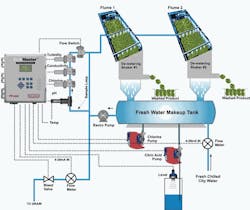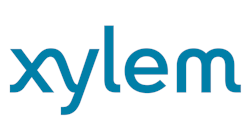By Michael Price
Ready-to-eat produce is growing in popularity across the globe. Any water that comes in contact with produce must be carefully treated and monitored since fresh produce is typically ingested without any further sanitation. There have been a number of instances over the last five years where illness was caused by improper disinfection of water used to irrigate, process, or wash produce.
Fruits and vegetables can be contaminated at a number of stages from the field to packing. The first area of concern is irrigation of the fields. Leafy vegetables are more susceptible than other types of vegetables or fruit due to the folds in the leaves that can harbor bacteria. If bacteria are present in the irrigation water, it can accumulate in these folds during spray irrigation.
To eliminate this potential source of contamination, it’s important to use an oxidant to control bacterial levels in the flumes and in the irrigation water. Achieving reliable control is possible through the automation of chemical addition and the monitoring of oxidant levels to ensure proper residuals and contact times are maintained. The oxidants that are typically used in these applications are chlorine dioxide, ozone, peracetic acid, or sodium hypochlorite.
Most fruit and vegetable processing plants use recirculating washing flumes. This makes it easier to maintain residual levels and oxidant contact time since changes are more gradual and the system allows for mixing of the chemical and water. Monitoring and control of the oxidant is achieved by controlling the chemical feed rate based on sensor measurements.
Oxidant monitoring sensors are usually one of two types: ORP or Ion selective. ORP (Oxidation Reduction Potential) sensors don’t measure a particular chemical but rather the intensity of the oxidation reactions. Ion selective sensors such as free chlorine, peracetic acid, chlorine dioxide or ozone are measuring particular ions and have a readout in parts per million.
Ion selective sensors typically have membranes that can be fouled by dirt and debris and oils. The use of a probe wash assembly extends the time between membrane cleaning. The probe wash can use air, water or water with an approved food grade chemical to remove the fouling substance. The pH of the wash water should also be controlled since the effectiveness of the oxidant (such as free chlorine and peracetic acid) is affected by the pH.
Disinfection by definition assumes a level of liability. To reduce liability, it’s important to monitor and maintain data associated with the disinfection process. When the process parameters are out-of-range, the system must alarm so that rapid corrections can be made or the process can be shut down. A local alarm, as well as email and text message alarming are beneficial. A short duration excursion on many parameters can cause serious problems, so it is important to have datalogs that will provide information on out-of-range conditions in intervals of 30 seconds or less. This data should be graphed to confirm compliance and identify trends. These graphs are a valuable tool for troubleshooting and for improving efficiency.
Other important parameters should be integrated, such as temperature, flow, chemical feed verification (to ensure the chemical pumps are functioning properly), ultrasonic level (on the chemical tanks) and possibly turbidity or conductivity to indicate when the water should be changed or diluted with fresh water.
Remote access to the system either inside the plant or from a different geographical location can be accomplished over a LAN, phone line, Ethernet radio or cell modem connection. This access allows QC and plant engineering to view the process and receive emails or cell phone text messages when problems exist in the disinfection process. Remote access can help ensure the problems are corrected in a timely manner and reduce the need for managers to visit remote sites.
As regulations become more stringent and liability increases, automated control, data logging, and remote communications will become the deciding factors in best available technology (BAT) and a mitigating factor in liability as well as an effective method for producing safe and healthy products.
About the Author: Michael Price is the Western US sales manager for Iwaki Walchem. He has a degree in Chemistry and has worked with water and associated systems for over 25 years utilizing controls, chemicals and biological solutions. Michael has experience in food and beverage, high purity water, environmental, municipal and industrial water systems.
CASE STUDY
Pulse Instruments in Van Nuys, CA, is a manufacturer of systems for disinfection in the fresh cut fruit and vegetable industry. The company has used customized WebMaster Industrial (WIND) Controllers in numerous plants throughout the US and Mexico.
The controller integrates sensors, control, data logging, and remote communications in a NEMA 4X waterproof enclosure. Direct sensor inputs are available for ORP, pH, free chlorine, chlorine dioxide, peracetic acid, and ozone. Relay outputs control chemical pumps, valves or other devices in the system.
Any other important parameter can be integrated, such as temperature, flow, feed verification (to ensure the chemical pumps are functioning properly), ultrasonic level (on the chemical tanks) and possibly turbidity to indicate when the water should be changed. All of these parameters can be monitored and controlled through the digital and analog inputs available in the WIND Controller.
“WIND controllers allowed us to integrate several individual processes, that were previously fragmented,” said Karan Khurana, the owner of Pulse Instruments. “Interdependent functions could utilize interlocks for improved performance. Built in data recording and communications create helpful diagnostics, and essential trace-back records.”



